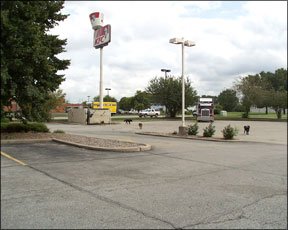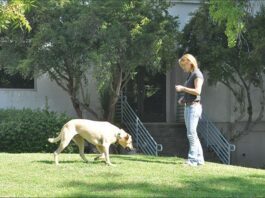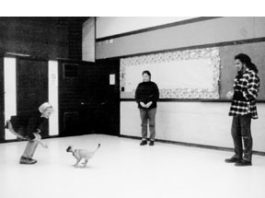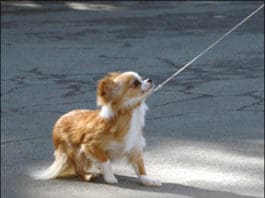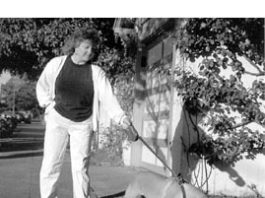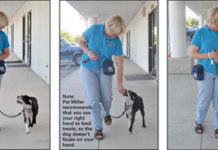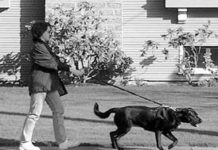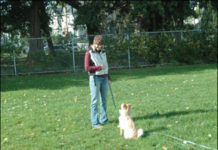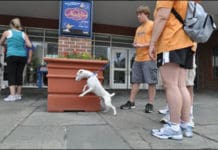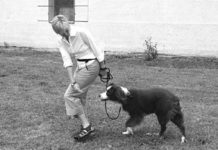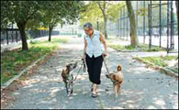How to Train Proper Leash Walking – Pull Over!
One of the more frustrating experiences for positive dog trainers is watching their clients being dragged by their dogs across the parking lot toward their cars, just moments after training class is dismissed. “Dang,” we sometimes think, “Will they ever teach their dogs to walk politely on-leash? What part of ‘Don’t reinforce your dog for pulling!’ didn’t they hear?” Of course, it’s equally frustrating for dog owners when their dogs drag them. And the training solution – stopping every time the dog pulls – gets tiresome.
No Miracle Products
These "no-pull" products can help you train your dog, but they don’t work at all if they are misused.
Dog Harness vs Collar: Which is Better?
Dog harnesses vs collars - which is safer? There are many types of collars and harnesses on the market, and some serve specific purposes.
Fitness Together
I confess: I have a hard time fitting in enough exercise for myself and my dog. Nothing earth-shattering about this admission; I think not getting enough exercise is a universal condition. Even though my dog and I walk daily, life and age just keep creeping up, making it harder and harder for me to stay fit. And, my high-energy herding dog seems to always need just a little more in the way of activity than I have time and energy to provide.
How to Teach Loose Leash Walking to Your Dog
with the treats delivered right at her side
Teaching a Reliable Recall
The recall response seems to come naturally to some dogs. For others, it’s a hard-won behavior. The Miller pack has some of both.
How to Train Your Dog to Calmly Walk on Leash
Passing by all manner of things in the real world - and being passed by them - is an important canine good manners skill. Unfortunately, it seems to be one that is absent in many dogs’ behavior repertoires. Some training classes don’t address this behavior challenge at all. Others do, but owners don’t always take time to generalize the behavior outside the training center. Their dogs, in the real world, still bounce over to greet any and all comers on the street, or on the opposite end of the continuum, shy away from people and things that frighten them. My “Downtown Hound” class graduated in early September with a celebration at Nutter’s Ice Cream in nearby Sharpsburg. It was a 90 degree-plus day with high humidity, and the ice cream parlor was a popular spot in this small Maryland community. I watched with pride as the four dogs lay quietly at their humans’ feet, happily downing the occasional offered dog treat while their owners licked ice cream cones. More importantly, they rested quietly as people walked by with strollers and dogs, kids on skateboards flew past noisily, and motorcycles, trucks, and cars rumbled by a few feet away on busy Main Street.
Some Great Leash-Walking Products
The best leash-walking products are effective in helping the owner train the dog not to pull (that is, they provide a large enough window of opportunity for the owner to successfully train the desired walking behavior), minimally aversive to the dog, easy to use, well-made, and affordable. (We put price last, since most owners of leash-pulling dogs would pay almost anything for a product that really helps them!)
Teach Your Dog to Walk on Leash
Walking politely at your side doesn’t seem like it should be so difficult to teach a dog, but it often proves to be the most challenging behavior for dog owners to achieve. Dogs who are letter-perfect with their sits and downs, targeting, and “leave it” exercises in the training center happily drag their owners across the parking lot to and from their cars before and after class.
Training Foster Dogs to Walk Properly On-Leash
My husband and I acquired two (temporary) canine foundlings last week. Julie is a five-month-old purebred Akita puppy that we rescued from our local shelter, where her cage card identified her as a Shepherd/Husky mix. Her prospects for adoption were dismal, given that the shelter euthanizes 85-90 percent of incoming animals. Our second castaway, Princess, is a three-year-old Beagle mix. My husband and I were driving down a busy highway when we spotted her, hunched in the middle of the road, defecating while cars swerved around her on both sides. Princess was wearing a collar and tag, but her owners had moved, and she ended up staying at our house for several days while we tracked down their new phone number and location.
Rocket Recall
but keep in mind that the leash is present only to keep your dog with you
Some Quick Tips for Loose Leash Walking
Joan Morse, CPDT-KA, CA-P1, CNWI, of Tailwaggers Canine Campus in Newark, Delaware, recommends Leslie McDevitt’s “Pattern Games” when teaching loose-leash walking. She describes one of those games: “The Two Step: drop a treat on the ground. Take two steps forward while the dog eats the treat. The moment he looks up at you, click, drop another treat right by you and take two more steps. This game develops a pattern or rhythm for the dog that will keep his attention on the handler and keep him moving as she moves. You usually get a nice loose leash walk quickly.”


